AngioDynamics, Inc. (NASDAQ:ANGO) Q2 2024 Earnings Call Transcript January 5, 2024
AngioDynamics, Inc. beats earnings expectations. Reported EPS is $-0.05, expectations were $-0.09. ANGO isn’t one of the 30 most popular stocks among hedge funds at the end of the third quarter (see the details here).
Operator: Good morning, and welcome to the AngioDynamics Fiscal Year 2024 Second Quarter Earnings Conference Call. At this time, all participants are in a listen-only mode. A question-and-answer session will follow the formal presentation. [Operator Instructions] As a reminder, this conference call is being recorded. The news release detailing AngioDynamics’ fiscal 2024 second quarter results crossed the wire earlier this morning and is available on the company’s website. This conference call is also being broadcast live over the Internet at the Investors section of the company’s website at www.angiodynamics.com, and the webcast replay of the call will be available at the same site approximately one hour after the end of today’s call.
Before we begin, I would like to caution listeners that during the course of this conference call, the company will make projections or forward-looking statements regarding future events, including statements about expected revenue, adjusted earnings and gross margins for fiscal year 2024, as well as trends that may continue. Management encourages you to review the company’s past and future filings with the SEC, including, without limitation, the company’s Forms 10-Q and 10-K, which identify specific factors that may cause the actual results or events to differ materially from those described in the forward-looking statements. The company will also discuss certain non-GAAP and pro forma financial measures during this call. Management uses these measures to establish operational goals and review operational performance and believes that these measures may assist investors in analyzing the underlying trends in the company’s business over time.
Investors should consider these non-GAAP and pro forma measures in addition to, not as a substitute for or as superior to, financial reporting measures prepared in accordance with GAAP. A slide package offering insight into the company’s financial results is also available on the Investors section of the company’s website under Events & Presentations. This presentation should be read in conjunction with the press release discussing the company’s operating results and financial performance during this morning’s conference call. I’d now like to turn the call over to Jim Clemmer, AngioDynamics’ President and Chief Executive Officer. Mr. Clemmer?
Jim Clemmer: Thank you, Rob, and good morning, everyone, and thanks for joining us today for our fiscal 2024 second quarter earnings call. Joining me on today’s call is Steve Trowbridge, AngioDynamics’ Executive Vice President and Chief Financial Officer, who will provide a more detailed analysis of our second quarter financial performance, as well as the manufacturing and restructuring that we announced this morning. Unless otherwise noted, all financial metrics and growth rates provided during the call today with respect to our results will be on a pro-forma basis, which excludes the impact of our divested Dialysis and BioSentry businesses. Before digging into our quarterly results, we are announcing significant steps in our long-term strategic transformation.
During the second quarter, we continue to actively pursue portfolio optimization opportunities and we made progress on that front. In addition, this morning, we announced a planned restructuring of our manufacturing footprint by moving to a fully outsourced model. With these moves, we will remain focused on generating continued growth across both our Med Tech and Med Device businesses, while simultaneously driving margin expansion. Importantly, when the dust settles from our initiatives at the end of our two year plan, we expect to achieve full year profitability in FY 2027. Both Steve and I will go into additional details later in the call. But now let me get back to Q2. Our second quarter of fiscal ’24 saw year-over-year growth but we also faced headwinds, particularly in our thrombectomy business.
We ended the second quarter with revenue of $79.1 million, representing growth of approximately 3% over year, led by growth of approximately 4% from our Med Tech segment. While growth of the Med Tech segment was a bit behind our expectations, particularly in mechanical thrombectomy, our adjusted EPS was a loss of $0.05 as we remain focused on our spending and managing operating expenses while still investing in long-term growth. Our mechanical thrombectomy business, which includes AngioVac and AlphaVac, declined 4.7% year-over-year. We are disappointed by these results as clearly the growth trajectory of this business is taking longer to inflect than we had expected. We attribute some of the softness to slightly weaker-than-anticipated procedural volumes late in our quarter, but we also believe the steps we are taking to drive this business are gaining positive traction.
For example, following on the heels of receiving the breakthrough designation for the use of AngioVac to remove right heart vegetation, we continue working diligently with the FDA toward receiving final approval to begin our IDE study. While AlphaVac revenues were softer than we would have liked this quarter, what we’ve learned over the past 18 months is that physicians value this durability, simplicity and safety of the device, and we look forward to the introduction of two new second-generation design enhancements that will make the product even more appealing later in calendar 2024. As announced in early December, we enrolled our final patient in our APEX-AV study, which is designed to assess the performance of the AlphaVac F18 system in reducing thrombus burden and improving right ventricular function.
We look forward to collecting data from this study at the 30-day follow-up stage, then submitting our data to the FDA in the early part of calendar year 2024 to support an expanded indication for AlphaVac F18 to treat pulmonary embolism. We believe the softer-than-anticipated AlphaVac sales during the quarter partially stem from a wind down at many of our sites as we approach the completion enrollment in the APEX-PE trial, and we expect some continued softness between the completion of the trial and the FDA approval of the PE indication as the device does not have a specific PE clearance and is competing against two existing products that do. We fully expect that once we receive our anticipated approval letter later this calendar year, we will have a highly competitive and differentiated product in what remains a large, underpenetrated, high-growth market.
Because of the tremendous interest from the physician community, we were able to complete our study as quickly as we did in a time that outpaced the previous competitive studies, and we are excited about the path ahead. Turning to our NanoKnife business, we saw sales grow approximately 2.8% during the second quarter, with sales of probes declining 3.6%. Probe sales grew in the U.S. but declined internationally due to timing of both bringing on new distributors during the previous year’s quarter and distributor orders during this year’s quarter. Stronger international capital sales during the quarter offset the decline in probes and will drive additional pro-growth in future periods as those units come online. Year-to-date, NanoKnife probes were up 12.9%, and total [NanoKnife] sales are up 16.7%.
We continue to expect strong growth from this business on an annual basis while anticipating quarter-to-quarter fluctuations in both probes and capital sales as historically has been the case. During the second quarter, we saw solid growth of our Auryon platform, up 12.9% year-over-year, and we’re excited to tell you that in November, we reached an important milestone, having achieved $100 million in cumulative revenue since we launched this product in September of 2020. We did experience some delays in sales related to the recent increased attention around preauthorizations, but we believe that over the long term, the unique way that we deliver laser energy and safely treat disease vessels will continue to drive increased share and provide the foundation for continued strong growth.
Growth of approximately 2% in our Med Device segment was primarily driven by angiographic catheter products and our ports, which grew 8% and 5.5%, respectively. In the second quarter of FY 2024, our international business grew 12.6% year-over-year, with double-digit growth from both our Med Tech and our Med Device segments. We also hosted our third international clinical life symposium, which has led to increased interest in our Med Tech products and we have generated a meaningful pipeline of global physicians who are excited to utilize our products in caring for their patients. Now turning to our strategic initiatives that I mentioned earlier. We told you over the past several quarters that we were further evaluating the products in our Med Device portfolio and we remain engaged in active discussions to do just that.
We advanced this initiative during the second quarter and we look forward to providing you with additional details soon when we are able to. In addition to our continued portfolio optimization efforts, we are also increasing our focus on reducing structural costs within our manufacturing footprint and transitioning our upstate New York manufacturing operations to a fully outsourced the model over the next two years. As a reminder, roughly 80% of our Med Tech revenue is already leveraging this third-party manufacturing model. As many of you already know, we began moving some of our Med Device manufacturing capacity to Costa Rica over the past couple of years as we began to see labor shortages in our upstate New York facilities. Fully moving both Med Tech and Med Device to this model will drive an annualized savings of roughly $15 million by our FY ’27, driving significant gross margin improvement, and equally as important, giving us a pathway to full year profitability by FY ’27.
Steve will cover this in more detail, but we believe this is a significant advancement of our long-term strategy that simplifies our operations while allowing us to invest in the long-term growth of our Med Tech portfolio and the overall business while still driving profitability. Shifting back to the near term. We’re excited for what lies ahead in calendar 2024. This month, we will commence the limited market release of our Auryon radio catheter, which will provide physicians an access point at the risk, enabling faster, less invasive procedures. This release will be the first of six planned product releases for Auryon during calendar year 2024. In the second half of year – calendar year 2024, we will launch two new design enhancements for AlphaVac, designed around physician feedback we’ve received and we’ll provide more details on those as we get closer to launch.

We’ve also got an exciting schedule of regulatory clearances on the horizon. We are projecting EU approval of Auryon and AlphaVac-PE in the first half of calendar year 2024. Next, we also expect U.S. approval of AlphaVac-PE mid-calendar year. And then finally, in July, the PRESERVE 12-month follow-up will be complete, putting us on track for potential FDA approval in late calendar 2024 or early calendar 2025. These introductions and regulatory clearances are critical parts of the strategy that we laid out for you in our July 2021 Investor and Technology Day. These open up significantly larger, higher-growth addressable markets. We are excited about the strategic initiatives that we’ve shared with you this morning and about the future of our portfolio, and we hope the impacts of our strategic transformation are becoming more apparent each quarter.
With that, I’ll turn the call over to Steve Trowbridge to review the quarter in more detail. Steve?
Steve Trowbridge: Thanks, Jim. Good morning, everyone. Before I begin, I’d like to direct everyone to the presentation on our Investor Relations website, summarizing the key items from our quarterly results. As Jim mentioned, unless otherwise noted, all metrics and growth rates mentioned during today’s call are on a pro forma basis and exclude the results of the dialysis and BioSentry businesses that we divested in mid-June. Similar to Jim, I’ll start with the second quarter before shifting to today’s strategic announcements. Our revenue for the second quarter of FY ’24 increased 2.7% year-over-year to $79.1 million, driven by growth in both our Med Tech and Med Device platforms. Med Tech revenue was $25.4 million, a 3.5% year-over-year increase, while Med Device revenue was $53.7 million, growing 2.3% compared to the second quarter of FY ’23.
Year-to-date, our overall revenue was up 4.2% year-over-year, with our Med Tech segment up 8.3%, and our Med Device segment up 2.3%. For the second fiscal quarter, our Med Tech platforms comprised 32.1% of our total revenue compared to 31.8% of total revenue a year ago. For the six months ended November 30, 2023, our Med Tech segment comprised 32.6% of our total revenue base versus 31.4% as of one year ago. Our Auryon platform contributed $11.4 million in revenue during the second quarter, growing 12.9% compared to last year. Year-to-date, our Auryon platform is up 18.9% year-over-year. Mechanical thrombectomy revenue, which includes AngioVac and AlphaVac sales, declined 4.7% over the second quarter of FY ’23. AlphaVac revenue for the second quarter was $1.9 million.
AngioVac revenue was $5.4 million in the quarter, representing a decline of 10.8% over the prior year. We did not see the rebound in AngioVac revenues that we had anticipated as procedure volumes came in lighter than expected, particularly late in the quarter. We remain confident that mechanical thrombectomy will be a strategic contributor to our long-term growth strategy and we are excited about the new product introductions that Jim mentioned as well as our clinical initiatives, such as the APEX pulmonary embolism study. NanoKnife disposable revenue during the quarter decreased 3.6% year-over-year. Disposable growth of 4% in the U.S. was offset by a year-over-year decline in international markets. As Jim said, the year-over-year quarterly decline in international markets was primarily driven by timing of distributor orders, although procedure volume remained very strong during the quarter.
Capital sales were robust in the quarter, growing 22.8% and this is a strong driver of future disposable sales. Year-to-date, NanoKnife disposable sales are up 12.9%, and total NanoKnife sales are up 16.7%. In addition, as a reminder, earlier this year, we announced that enrollment in PRESERVE is now 100% complete. And as this data starts to be made public over the course of this year, we look forward to sharing it with you. In the second quarter, our Med Device segment grew 2.3% year-over-year, led by strength in our angiographic catheter and port products. Moving down the income statement. Our gross margin for the second quarter of FY ’24 was 50.9%, a decrease of 80 basis points compared to the year ago period. For the second fiscal quarter, Med Tech gross margin was 62.4%, a decrease of 130 basis points, and Med Device gross margin was 45.5%, a decrease of 60 basis points, each when compared to the second quarter of last year.
The year-to-date gross margin for FY ’24 was 50.8%, a decrease of 60 basis points versus prior year, with Med Tech gross margins of 63.5% and Med Device gross margins of 44.7%. Year-over-year gross margins for both the quarter and year-to-date were positively impacted by sales volume, production volume and reduced cost for both freight expenses and direct labor retention payments but were offset by sales mix, hardware placements and continued, albeit reduced, material and labor inflation. As we’ve discussed, our strategic business model contemplates gross margin expansion as our higher-margin Med Tech segment continues to become a larger portion of our overall revenue base. As mentioned last quarter, the next phase of our transformation is to address the scale and structural limitations of our operating footprint in a capital-efficient manner.
This morning’s announcement regarding restructuring our manufacturing footprint and transitioning our upstate New York manufacturing operations to a fully outsourced model will address these structural cost limitations, meaningfully improve gross margins and lead to full year adjusted EPS profitability in FY ’27. We expect that our manufacturing restructuring will result in annualized savings of roughly $15 million, with the full annualized impact being realized in FY ’27. In addition, as we previously discussed, we’re continuing to have productive conversations around further optimizing our portfolio and we will provide you with more details when appropriate. Turning to R&D. Our research and development expense during the second quarter of FY ’24 was $8.7 million or 10.9% of sales, compared to $6.8 million or 8.8% of sales a year ago.
Spending on clinical programs was 18.8% of total R&D spend during the second quarter of fiscal ’24, compared to 14.1% during the second quarter of last year, and 18.6% for the full fiscal year 2023. This mixed shift within our R&D spending is well aligned with our long-term strategy to support increased physician adoption of our Med Tech platform technologies through the generation of data and clinical evidence. SG&A expense for the second quarter of FY ’24 was $34.8 million, representing 44% of sales, compared to $36.8 million or 47.8% of sales a year ago. Our adjusted net loss for the second quarter of FY ’24 was $2 million or adjusted loss per share of $0.05 compared to an adjusted net loss of $3.6 million or adjusted loss per share of $0.09 in the second quarter of last year.
Adjusted EBITDA in the second quarter of FY ’24 was $1.8 million compared to adjusted EBITDA of $2.3 million in the second quarter of FY ’23. In the second quarter of fiscal ’24, we generated $5.3 million in operating cash, had capital expenditures of $0.6 million, in additions to Auryon placement and evaluation units of $1.2 million. At November 30, 2023, we had $60.9 million in cash and cash equivalents compared to $44.6 million in cash and cash equivalents at May 31, 2023. And as a reminder, we have zero debt on the balance sheet. Turning now to guidance. We now anticipate that FY ’24 revenue will be in the range of $320 million to $325 million, below our prior guidance of $328 million to $333 million. This accounts primarily for the softer thrombectomy sales during the fiscal second quarter, which we now expect will continue throughout the back half of the year as well as certain SKU rationalization and other impacts associated with the manufacturing restructuring we announced this morning.
We now expect full year adjusted loss per share to be in the range of $0.35 to $0.42. We expect FY ’24 gross margin to be in the range of 49% to 51% compared to pro forma FY ’23 gross margin of 50.5% as a result of the mixed shift occurred due to the lower expected Med Tech. For FY ’24, we now expect Med Tech revenue growth in the range of 10% to 15%, down from 20% to 25% to account for the thrombectomy weakness we saw during the second quarter persisting through the remainder of this year. We continue to expect Med Device revenue growth in the range of 1% to 3%. We now expect Med Tech gross margins in the range of 61% to 63%, and Med Device gross margins in the range of 43% to 45%. As we mentioned earlier, we expect the manufacturing restructuring to have a meaningful impact on our margin structure over the coming years and look forward to providing you with more details as that work gets underway in the coming months.
Today’s announcement is a significant step in our strategic transformation that gets us closer to the company we strive to be. A profitable business focused on unique medical technology platforms that improve patient outcomes in large underpenetrated high-growth markets. Finally, I would like to thank our team here at AngioDynamics for their hard work and commitment, and we’re looking forward to sharing more about these initiatives with you in the coming months while executing further on our strategy and delivering a strong second half for fiscal ’24. With that, I’ll turn it back to Jim.
Jim Clemmer: Thanks, Steve, and for those joining, thank you for your time this morning. What you see is a company in transformation, looking to do the balance today of making sure our investments and costs that we spend are aligned to the outcomes that we want to see in the markets we serve and the markets we seek to grow in. Taking out significant structural costs, we don’t have a lot of product, our customer benefit are important steps in that. We’ll continue to do that with an eye to the bottom line, but also maintaining investments to optimize the opportunity that we’ve set forth in front of us. We have unique opportunities in large and fast-growing markets. We want to make sure we can maximize the opportunity to treat cardiovascular disease, primarily in venous or in arterial needs.
We also know that our unique NanoKnife can treat solid tumors in areas like prostate cancer. We look forward to following our customers to where they seek to grow with our products. Thanks for joining us today. Rob, I’ll turn it back to you.
See also 10 Stocks Receiving a Massive Vote of Approval From Wall Street Analysts and These Dow Stocks Will Boost Their Dividends Soon.
Q&A Session
Follow Angiodynamics Inc (NASDAQ:ANGO)
Follow Angiodynamics Inc (NASDAQ:ANGO)
Operator: [Operator Instructions] We have our first question coming from the line of Yi Chen with H.C. Wainwright. Please proceed with your question.
Yi Chen: Thank you for taking my question. Just want to clarify. The gross margin, will it continue to decrease until you complete the shift to serve third-party manufacturing?
Steve Trowbridge: You’ll see some back and forth, Yi. Thanks for the question. There are going to be costs that are going to be taken out through this process. You’re going to see the most impactful benefit come when we are able to finally close the doors and do that full shift to the manufacturing. As we head into giving you guidance for future years, as we move into ’25 and ’26, we’ll give you a little bit more clarity around the cadence from that. So I would expect you’re going to see a little bit of movements, but with that most significant movement coming at the end of the two year period, and then certainly being there for the full year of FY ’27.
Jim Clemmer: And Yi, during that two year period as well, the product mix shift as the Med Tech products that have a higher gross margin than our corporate gross margin average will become a faster-growing piece. So as long as Steve said, as we take those costs out of the back end, we also expect to see a mix shift that’s positive throughout that two year cycle and far beyond. Thanks.
Yi Chen: Thank you. And regarding the sales from thrombectomy, are there any factors that you expect to drive the sales to increase the sales in the coming years?
Jim Clemmer: There are, Yi. First of all, with AngioVac, again, announcing the breakthrough designation that we received from the FDA a few months back, and then getting that IDE aligned to our expectations to graft to the right heart vegetation opportunity that we think is significant for AngioVac, but larger than that AlphaVac. Yi, we mentioned on the call earlier that we look forward to have our CE Mark in the first half of calendar year 2024, opens up a significant market for us. And it’s timed almost in the same series that will get, we believe, our FDA indication for our PE for the F18 here in the U.S. So over the next six months, we’ll work hard to educate and train our sales and clinical teams and get ready to go to the markets that we can serve.
These are really large markets. What we’ve learned during the APEX study from AlphaVac, that physicians really like the novel design features in the product. The study would not have been completed as fast as it was if people didn’t see the novel design elements that led to what we think are really positive patient outcomes. So, Yi, really, we’ve got to sit tight for a bit and make sure we’re prepared for a full global launch later in calendar 2024.
Yi Chen: That’s very helpful. Thank you very much.
Operator: Thank you. And our next question comes from the line of John Young with Canaccord Genuity. Please proceed with your questions.
John Young: Hi, Jim and Steve, can you hear me okay?
Jim Clemmer: Thanks John. Good morning.
John Young: Good morning. Thanks for taking our question. Just maybe on AngioVac to start, can you just go a little bit more in detail about the headwinds that you’re talking about. I know in the past, you put new sales leadership and training there and you recently got the breakthrough device designation, right heart vegetation. What isn’t working there? And what are you going to do to remedy this?
Jim Clemmer: John, for AngioVac, it’s been a challenge. We mentioned before that we service smaller market opportunity with AngioVac than we do with AlphaVac. So opening up that right heart vegetation opportunity that we’re working with the FDA on is important for us. But again, AngioVac is only going to serve a limited market. What we’ve done since we talked to you last summer, a brand new sales leader who’s terrific built a new sales team, around some people that were here already that knew the products wanted to work in this environment when we open up these new markets, and AlphaVac-PE being the largest. We’ve also fully realized now a new training module and we fully staffed our sales force for the first time. So we’re really ready.
We’re in a phase now. We’re training and developing their capabilities, getting them educated, and the markets will serve both for AngioVac, as you mentioned, which is complex, as you know, and limited and their larger, less limited market that is open to us in the future when the AlphaVac-PE becomes granted. So we’re doing our work in the back end, training and educating our teams, our clinical and sales teams to open up these markets.
John Young: Great. Thanks, Jim. And then just on shifting to AlphaVac 2, you mentioned that the 2.0 is going to launch this calendar year. Can you talk about the improvement? And do you now see any ASP increases with that? And can you maybe just talk about today, the pricing versus the market and your pricing on par or above or below the market? Thank you.
Jim Clemmer: Good question, John. So AlphaVac is really a unique and novel device. And again, I’ll let the study speak for itself. Hopefully, you’ll see some data being published this calendar year with study results when they become available. But there’s some design elements that are unique. For instance, physicians are so used to placing wires when you’re treating this part of the anatomy and guiding catheters through the anatomy, which is torturous, which usually guide wires and so forth. We designed the AlphaVac with one of the unique design elements is that you don’t need to drop a wire or place a wire. Most physicians look at it like, why wait a minute, you can’t do that, and they still can do that if they choose. But over time, we found they get confident and comfortable with the design elements of the device.





